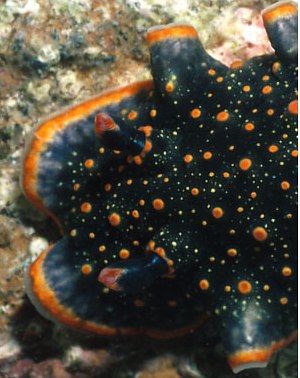Glossodoris edmundsi and G. ghanensis
May 22, 2003
From: Bill Rudman

Terry Gosliner's photo from the Azores of what he has identified as Glossodoris edmundsi Cervera, Garcia-Gomez & Ortea, 1989 gives me the opportunity to discuss this and G. ghanensis Edmunds, 1968, which I consider to be the same species. In their description of
Colour: There is some variation in background colour, with the grey black pigmentation in some animals being less intense than in others. The orange pigmentation can also vary from orange-red to orange-yellow. However, in all essential points there are no differences in colour pattern, including such fine detail as the 3 orange lines on the rhinophore clubs - one in the posterior midline, and one on each side running from the tip to about halfway down the club. (Gosliner, 1990; Edmunds, 1981; Ortea et al, 1996) Another feature of the colour pattern which shows both colour variation and fine detail is the submarginal orange border. In Edmund's original description of G. ghanensis (1968) he desribes the border as 'orange' but in 1981 he describes it as 'orange merging into yellow' which is clearly visible in the accompanying colour photo. Although both Cervera et al (1989) and Ortea et al (1996) describe the border of G. edmundsi as 'orange', in Gosliner's photo it is submarginal and grades from a dark brownish orange on the outside to lighter orange on the inside.
Radula: Cervera et al (1989) compare the radula of a 14mm long alive specimen of G. ghanensis from Ghana, and a 34-5mm long specimen alive of G. edmundsi from the Canary Ids. The Ghanaian animal is almost certainly immature, and the teeth of immature specimens are usually more denticulate than adults. Taking into account the differing maturity of the animals compared and the fact that the comparisons were made from light microscope mounts, I can see no major conflict in the denticulation of the outer teeth in the two descriptions. If you compare Edmunds' (1968) drawing of the outer teeth of a specimen from Ghana, with Ortea et al's (1996) SEM photo of the outer teeth of a specimen from Madeira, and Gosliner's (1990) from the Azores, they look very similar.
Reproductive System: As with the radular morphology, I would suspect the comparison of the reproductive systems (Cervera et al, 1989) is based on an immature specimen of G. ghanensis. I am not sure therefore how much weight we can put on differences in relative lengths of ducts, or sections of ducts in the reproductive systems. Certainly in juveniles, parts that in maturity become glandular, or muscular, are present as long, often coiled, thin-walled ducts, the glandular and muscular coatings appearing gradually as the animal matures. It is therefore difficult in immature or half grown animals to identify particular sections of the male duct. Later dissections by Ortea et al (1996) and Gosliner (1990) illustrate the reproductive system of G. edmundsi and both have differences in the relative lengths and thicknesses of parts of the male duct.
Finally, the most recent review of G. edmundsi studied specimens from Azores, Madeira, and Ghana (Ortea et al, 1996). If G. edmundsi and G. ghanensis both occur in Ghana, this is either an amazing case of mimicry or we are dealing with the same species. Clearly mimicry cannot be ignored, as the chromodorids are well-known for their groups of similarly coloured species. However, in my experience, species mimicking each other are never identical, there are always slight differences, perhaps in rhinophore or gill colour, or perhaps an extra colour bordering the mantle. Differences in colour pattern should not be confused with variation in colour pigment. As we see in these two 'species', variation in intensity and shade of a particular colour - say from orange-red to orange-yellow - is quite normal in many nudibranchs. Variation in colour intensity however, does not alter the colour 'pattern' of a species, which we can define as the manner in which all the colours are arranged in a particular species.
• Cervera, J.L., Garcia-Gomez, J.C. & Ortea, J.A. (1989). On two rare chromodorid nudibranchs (Opisthobranchia: Chromodorididae) from the Eastern Atlantic, with the description of a new species of Glossodoris, Journal of Molluscan Studies, 55: 445-453
• Edmunds, M. (1968) Opisthobranchiate Mollusca from Ghana. Proceedings of the Malacological Society of London, 38: 83-100.
• Edmunds, M. (1981) Opisthobranchiate Mollusca from Ghana: Chromodorididae. Zoological Journal of the Linnean Society, 72(2): 175-201.
• Gosliner, T.M. (1990). Opisthobranch Mollusks from the Azores Islands. 1. Runcinidae and Chromodorididae. Açoreana, supplement: 135-166
• Ortea, J., Valdes, A. & Garcia-Gomez, J.C. (1996) Review of the atlantic species of the Family Chromodorididae (Mollusca: Nudibranchia) of the blue chromatic group. Avicennia (Suppl. 1): 1-160.
Best wishes,
Bill Rudman
Related messages
-
Glossodoris ghanensis laying eggs
From: Marina Poddubetskaia, June 23, 2005 -
Glossodoris ghanensis from Senegal
From: Marina Poddubetskaia, June 26, 2003 -
Glossodoris edmundsi from the Azores
From: Terry Gosliner, May 22, 2003
